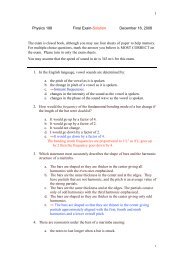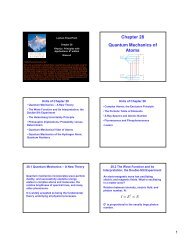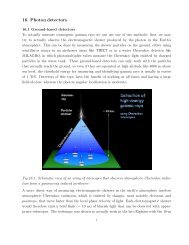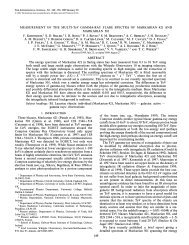Gamma-Rays Produced in Cosmic-Ray Interactions and TeV-band ...
Gamma-Rays Produced in Cosmic-Ray Interactions and TeV-band ...
Gamma-Rays Produced in Cosmic-Ray Interactions and TeV-band ...
You also want an ePaper? Increase the reach of your titles
YUMPU automatically turns print PDFs into web optimized ePapers that Google loves.
us<strong>in</strong>g the Monte Carlo method is that the codes can be used directly for calculations of all<br />
secondary products. However, it is quite useful to have simple representations to <strong>in</strong>vestigate<br />
the fundamental spectral characteristics. In this work, the Monte Carlo event generator,<br />
DPMJET-III, is used to simulate the secondary production <strong>in</strong> cosmic-ray generated hadronic<br />
<strong>in</strong>teractions.<br />
The Monte Carlo event generator DPMJET [27], is constructed for sampl<strong>in</strong>g hadronhadron,<br />
hadron-nucleus, nucleus-nucleus <strong>and</strong> neutr<strong>in</strong>o-nucleus <strong>in</strong>teractions from a few GeV<br />
up to very high energies. DPMJET is an implementation of the two-component Dual Parton<br />
Model for the description of <strong>in</strong>teractions <strong>in</strong>volv<strong>in</strong>g nuclei, <strong>in</strong>clud<strong>in</strong>g photonproduction<br />
<strong>and</strong> deep <strong>in</strong>elastic scatter<strong>in</strong>g off nuclei. It is based on the Gribov-Glauber approach <strong>and</strong><br />
treats both soft <strong>and</strong> hard scatter<strong>in</strong>g processes <strong>in</strong> an unified way. Soft processes are parameterized<br />
accord<strong>in</strong>g to the Regge-phenomenology whereas lowest-order perturbative QCD<br />
is used to simulate the hard component. Multiple-parton <strong>in</strong>teractions <strong>in</strong> each <strong>in</strong>dividual<br />
hadron/nucleon/photon-nucleon <strong>in</strong>teraction are described by the PHOJET event generator.<br />
The fragmentation of parton configurations is treated by the Lund model PYTHIA.<br />
As a new feature, DPMJET-III allows the simulation of enhanced graph cuts <strong>in</strong> nondiffractive<br />
<strong>in</strong>elastic hadron-nucleus <strong>and</strong> nucleus-nucleus <strong>in</strong>teractions. For example, <strong>in</strong> an<br />
event with two wounded nucleons, the first nucleon might take part <strong>in</strong> a non-diffractive<br />
<strong>in</strong>teraction whereas the second one scatters diffractively produc<strong>in</strong>g only very few secondaries.<br />
Further features of DPMJET-III are a formation-zone <strong>in</strong>tranuclear cascade <strong>and</strong> the<br />
implementation of certa<strong>in</strong> baryon stopp<strong>in</strong>gs.<br />
DPMJET-III <strong>and</strong> earlier versions such as DPMJET-II have been extensively tested<br />
aga<strong>in</strong>st data <strong>in</strong> hadron–nucleus <strong>and</strong> nucleus–nucleus collisions [27, 37, 38], for the simulation<br />
of cosmic-ray air shower problems [39], <strong>and</strong> for the atmospheric γ-ray <strong>and</strong> neutr<strong>in</strong>o<br />
production [40]. Although DPMJET has reproduced well the experimental data <strong>in</strong> hadronic<br />
collisions over a quite broad <strong>in</strong>cident energy range, it appears to produce unphysical structure<br />
near the threshold energy of pion production. Figure 1 shows the π 0 <strong>and</strong> π ± production cross<br />
sections <strong>in</strong> function of the k<strong>in</strong>etic energy of protons <strong>in</strong> pp collisions simulated by DPMJET-<br />
III. The experimental values are taken from references [10, 29, 41] up to E p = 2 <strong>TeV</strong>. To<br />
be noted from the figure is that the DPMJET results agree with the data except the energy<br />
range E k ≤ 2 ∼ 3 GeV. For a high-energy physics event generator this is not uncommon<br />
behavior. The energy region <strong>in</strong> question corresponds to the resonance region relat<strong>in</strong>g to<br />
6







